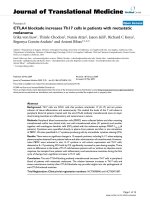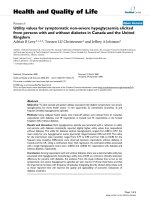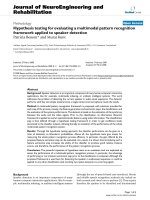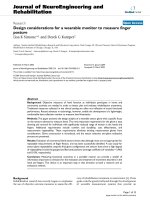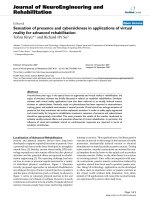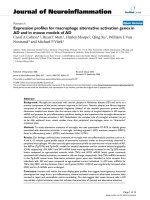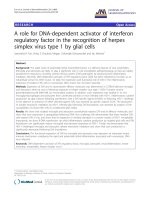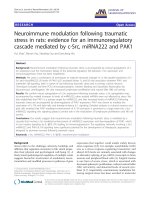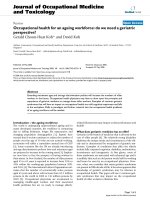Báo cáo hóa học: " Beamforming techniques for enabling spatialreuse in MCCA 802.11s networks" pdf
Bạn đang xem bản rút gọn của tài liệu. Xem và tải ngay bản đầy đủ của tài liệu tại đây (918.42 KB, 13 trang )
RESEARCH Open Access
Beamforming techniques for enabling spatial-
reuse in MCCA 802.11s networks
Y Lebrun
1,2*
, K Zhao
4
, S Pollin
1
, A Bourdoux
1
, F Horlin
3
,SDu
4
and R Lauwereins
1,2
Abstract
We address the problem of co-channel interference (CCI) in wireless mesh networks based on the IEEE802.11s
extension. The carrier sensing mechanism deployed in those networks insufficiently addresses the CCI problem,
causing the hidden and exposed node problems; consequently degrading the throughput and latency. In this
paper, we show how beamforming techniques can be implemented on top of the IEEE802.11s medium access
control protocol and, using the information readily available, cancel the interference to mitigate this inefficiency of
carrier sense and improve the spatial-reuse gain. In addition, we pro pose the signal-to-jamming-noise ratio (SJNR)
beamformer and show that it significantly improves the spatial-reuse gain compared to the simple zero-forcing
(ZF) beamformer and the basic IEEE802.11s access scheme. We derive the ergodic capacity of the ZF beamformer
and the basic IEEE802.11s access scheme and simulate the performance of the various schemes. We show that
improvements of up to 85% are achieved as function of the scenario simulated and the beamforming technique
used and that the SJNR scheme outperforms the standard ZF beamformer.
Keywords: wireless mesh network (WMN), IEEE802.11s, beamforming, zero-forcing (ZF), signal-to-jamming-noise
ratio (SJNR), spatial-reuse
1. Introduction
A wireless mesh network (WMN) based on the
IEEE802.11s extension [1], as shown in Figure 1, can
exploit neighbor nodes to relay the information through
multiple hops in the network and increase the spectral
and power efficiency. WMNs have recently been consid-
ered in wireless standards, e.g., the 802.15.5 [2] and the
802.16e [3], and are still seen as a promising research
area in wireless communications. In such networks, an
efficient spatial-reuse is imperative to maximize the use
of the available spectrum and provide the required qual-
ity of service (QoS) in terms of throughput and latency
[4]. Spatial-reuse means that multiple nodes communi-
cate concurrently, using the same time/frequency
resources. However, the medium access control (MAC)
protocol of IEEE802.11s networks re lies on c arrier sen-
sing for granting access to the medium. This carrier
sense mechanism causes the hidde n node problem, i.e.,
whenanodethatisabletointerferewithanongoing
transmission is not silenced, and the exposed node pro-
blem, i.e., when a node is silenced even when a trans-
mission from this node does not cause a collision at the
receiver. These problems are known to limit the spatial
reuse, consequently degrading the performance of the
network [5].
When sensing the medium as busy, nodes part of an
IEEE802.11s network refrain from transmitting to pre-
vent collisions at the receiver. Therefore, co-channel
interference (CCI) will considerab ly impact the transmit
opportunities of the few relay stations (STAs) close the
access point (AP) of a mesh network that aggregates
most of its traffic towards these nodes, i.e., they will
block each other when transmitting. To improve spatial-
reuse, it is then needed to allow relay STAs to transmit
often(i.e.,noexposednodes)whileavoidinginterfer-
ence from neighbor relay STAs (i.e., no hidden nodes).
Achieving this in a distributed way is the ultimate goal
of every distributed wireless system.
Many techniques have been proposed in the literature
to mitigate these problems, ranging from contention
window adaptation, transmit power control [6], tuning
of the threshold [7] to rate adaptation [8] and routing
* Correspondence:
1
Interuniversity Micro-Electronics Center (IMEC), Kapeldreef 75, 3001 Leuven,
Belgium
Full list of author information is available at the end of the article
Lebrun et al. EURASIP Journal on Wireless Communications and Networking 2011, 2011:136
/>© 2011 Lebrun et al; l icensee Springer. This is an Open Access article distributed under the terms of t he Creative Commons Attribution
License ( which permits unrestricted use, distribution, and reproduction in any medium,
provided the original work is properly cited .
[9]. All techniques aim at balancing the negative impact
of the expo sed node versus the hidden node pr oblems.
Forexample,anincreaseintransmitpowerimproves
the energy received at the receiver and silences more
nodes (increases the blocking area) hence decreasing the
number and impact of h idden nodes collisions. How-
ever, this comes at the cost of a higher number of
exposed nodes hence degrading the spatial-reuse gain.
In [10], it i s shown that the exposed node problem,
when relying on distributed resource allocation, s hould
notbeavoidedbutthatthereisanoptimaltrade-off
between the two problems. No MAC-layer techniques
only is capab le of removing the inefficiencies of the hid-
den versus exposed node problems.
In addition, PHY-layer techniques may be used to
cancel the interference and prevent a collision at the
receiver [11-13]. For example, zero-forcing (ZF) beam-
forming for interfe rence cancel latio n has been shown to
increase the capacity of ad-hoc networks [14]. B eam-
forming is indeed a promising approach to mitigate the
negative impact of the CCI, i.e., the c oncurrent node
may transmit even though it senses the channel as bu sy.
However, to apply the optimal weights on each antenna
and cancel interference, these techniques require the
perfect channel state information (CSI) between the
transmitter and the ongoing and targeted nodes. This is
difficult to implement in such distributed networks and
requires an adaptation of the MAC protocol [15,16].
Alternatively, techniques exist that rely on partial CSI
that is obtained by the request to send/clear to send
(RTS/CTS) frames, e.g., the circular transmissions of the
RTS frames [17]. These schemes that rely instead on
sub-optimal beamforming or imperfect CSI hence pro-
vide not-optimal performance. In [18], the RTS/CTS
frames are used to acquire the partial CSI and focus the
energy towards the targeted receiver, instead of cancel-
ing the CCI this increases the throughput and mitigate s
the hidden node problem, e.g., the receiver is more resi-
lient to interference. Such a scheme can also be used to
reduce the transmit power while achieving the same
performance hence reducing the generated interference
and mitigating part of the exposed node problem [19].
Alternative methods to obtain imperfect CSI, e.g., esti-
mation of the loca tion from GPS or the angle of arrival,
have also been proposed but provide also sub-optimal
performance [20]. Moreover, in addition to the CSI, pre-
cise timing information is needed at the concurrent
transmitter for synchronization, i.e., the timing informa-
tion of the user it does not harm. Furthermore, the
communication protocol may use an acknowledgment
(ACK) frame to confirm the successful transmission,
this is a possible source of collisions. Implementation of
beamforming techniques is hence promising but chal-
lenging to achieve in practical scenarios.
To conclude, mitigating the negative impact of CCI is
key to improve the number of spatial-reuse opportu-
nities in the IEEE802.11s network and provide the
required QoS. As introduced above, there is a
Figure 1 In this paper, we propose a new solution to improve the performance of mesh networks.ThisisachievedbysolvingtheCCI
problem by coupling the MAC protocol with distributed beamforming. As a result, the relaying mesh station that was blocked, i.e., because of
the interference link, is now allowed to transmit. We show that significant spatial-reuse gains can be achieved depending on the scenario and
the beamforming technique used. For the beamforming, a new scheme is proposed that outperforms the standard ZF beamformer and the
basic access scheme.
Lebrun et al. EURASIP Journal on Wireless Communications and Networking 2011, 2011:136
/>Page 2 of 13
fundamental trade-off betw een the exposed and h idden
node problems and several MAC-layer techniques have
been proposed to tackle it. However, these techniques
do not achieve optimal performance. A further step con-
sists then in exploiting PHY-layer techniques, i.e., beam-
forming, to apply weights on each transmit antenna to
mitigate the interference and maximize the spatial-reuse.
In centralized networks, the timing, cha nnel and data
information are available at the central coordinator
which can then share such i nformation with selected
users to enable concurrent or coope rative transmissions.
This is, e.g., t he case with the coordinated multipoint
(CoMP) technique in LTE-advanced systems [21]. How-
ever, in distributed networks the sharing of information
is difficult because of the lack of coordination among
the users. The challenge lies then in acquiring the chan-
nel and synchronization information in such a decentra-
lized network without change in the MAC protocol.
In this paper, we show how beamforming techniques
can be implemented on top of the mesh coordinated
channel access (MCCA) IEEE802.11s MAC protocol
and, using the information readily available, improve the
capacity and latency of such networks (the generaliza-
tion of the proposed method to any distributed protocol
is hence not possible). Secondly, we propose the signal-
to-jamming-noise ratio (SJNR) beamformer to balance
the interference and signal quality of the intended re cei-
ver, and show that it significantly improves the spatial-
reuse gain compared to the simple ZF beamformer and
the basic IEEE802.11s access scheme. The specific sce-
nario that we consider for the performance analysis is
an IEEE802.11s network, composed of two relaying sta-
tions source of most of the traffic and close to each
other, hence blocking each other’s channel access when
transmitting if no precautions are taken.
The overview of the IEEE802.11s and the MAC
MCCA mechanisms to access the channel are given in
Section 2; the concrete scenario and goal of the study is
then presented in S ection 3. Section 4 presents the sys-
tem model and the derivations of the ergodic capacity
for the considered system with the basic IEEE802.11s
and the ZF schemes and introduce the SJNR beamfor-
mer (Section 4-D). Simulations in Section 5 show the
performance of the different schemes. These results are
discussed together with the proposed analytical deriva-
tions. Section 6 concludes our paper.
We use the following notations. The vectors and
matrices are in boldface letters, vectors are denoted b y
lower-case and matrices by capital letters. The super-
script (·)
H
denotes the Hermitian transpose operator and
(·)
†
denotes the pseudo-inverse, E[·] is the expectation
operator. I
N
is an identity matrix of size (N × N)andℂ
N ×1
denote s the set of complex vectors of size (N ×1).
The definition x ~ ℂ N(0, s
2
I
N
) means that the vector x
of size N × 1 has zero-mean Gaussian distributed inde-
pendent complex elements with variance s
2
.Wedefine
a
n
as the nth element of the vector a.
2. Background: IEEE802. 11s and MCCA
mechanism
The IEEE802.11s is an amendment to the IEEE802.11
standard that specifies the physical -and MAC-layer spe-
cifications for enabling mesh networking for WLANs.
Devices within such a network can exploit multi-hop
comm unications to relay the information cleverly in the
network as illustrated in Figure 1.
Access to the channel is handled by the mesh coordi-
nation function (MCF) which consists of the EDCA, a
QoS-enhanced version of the well-known basic distribu-
ted coordination function (DCF), and the o ptional
MCCA protocols. In this work, focus is on the MCCA
protocol and the information sharing it facilitates. The
MCCA is a scheduled resource allocation method, in
which the schedule is determined in a distributed way.
It results in contention-free communications in contra st
with the EDCA mechanism. The schedule allows to
determine and learn about transmissions in advance,
which facilitates distributed beamforming techniques
that require such coordination among t he different
transmitters. Below, the beaconing a nd reservation pro-
tocol are detailed.
In such network, the mesh stations use the enhanced
distribut ed channel access (EDCA) or the optional mesh
coordinated channel access (MCCA) mechanisms to
access the channel. Although those modes differ, they
both rely on carrier sensing for granting access to the
channel. The EDCA scheme is a contention-based
mechanism which itself is an improved variant of the
basic IEEE802.11 DCF. Implementing spatial-reuse for
such a mode is challenging and would require prior
cooperation between the mesh stations. On the other
hand , the MCCA mechanism is a non-contenti on-based
process where the t ransmit opportunities (TXOP) ar e
allocated in the future. Because each STA advertises its
reserved TXOPs, both the CSI and the timing informa-
tion for enabling beamforming may be obtained.
A. Beaconing and synchronization
With the MCCA mechanism, STAs broadc ast beacon
and delivery traffic indication messages (DTIM) frames
on a periodic b asis. These frames are used for advertis-
ing the scheduled transmissions and synchronization
purpose, e.g., for the STAs to detect and join the net-
work. In addition, to prevent a STA outside the beacon
range to conflict with existing scheduled transmissions,
STAs include the transmit opportunities of their neigh-
bors in their beacon and DTIM frames. Nearby mesh
STAs listen then to these frames to update their
Lebrun et al. EURASIP Journal on Wireless Communications and Networking 2011, 2011:136
/>Page 3 of 13
network allocation vector (NAV) accordingly. The NAV
works as a virtual carrier sensing and indicates the
scheduled transmissions and hence t he duration for
which a STA must defer from accessing the channel.
Figure 2 shows an example of the beacon and DTIM
frames structure.
B. Distributed reservation protocol
The optional medium access protocol called MCCA is a
distributed reservation mechanism that allows mesh sta-
tions to avoid frame collisions by reserving transmit
opportunities in t he future, called MCCA opportunities
(MCCAOPs). The handshake process is detailed in Fig-
ure 3. Most importantly, the MCCAOP contains
detailed timing information such as the start and dura-
tion of the intended transmission. Nodes overhearing
the handshake will hence know that information and be
able to use it. In addition, nodes overhearing the
MCCAOP Setup Reply from the intende d receiver will
be able to determine an estimate of the channel between
themselves and that intended receiver. As a r esult, both
timing and CSI informations are available and can be
used by the physical layer beamformer to mitigate
interference.
The MCCAOP control frames are transmitted when
no MCCAOPs have been scheduled. The mesh STAs
compete then to access the medium using the basic
EDCA mechanism and gain access to the medium if it
senses the channel idle for a duration in line with the
EDCA access category. At the beginning of an MCCA
reservation, the STAs other than the MCCAOP owner
refrain from accessing the channel. In this paper, the
goal is to study the spatial-reuse opportunities during
the planned MCCAOP, which means, studying if it is
feasible to access the channel simultaneously without
causing severe interference to the receiver. This minimal
interference should be realized by implementing a (dis-
tributed) beamforming scheme using information that is
available after the first MCCAOP establishment. No
extra MAC layer overhead should be added, and the
spatial-reuse gains realized should hence be net and rea-
lized above the MAC layer with its associated overhead.
3. Scenario and problem formulation
We propose how to combine advanced distributed
beamforming techniques at physical layer to increase
the overall network capacity. We show how these tech-
niques can be implemented on top of the IEEE802.11s
MAC protocol and the info rmation available from the
MCCA mechanism.
The scenario of interest consists of an IEEE802.11s
system where the coverage areas of two relay STAs
overlap. Because the IEEE802.11s system relies on (vir-
tual) carrier sensing for accessing the channel, the two
relays then block each other’s transmissions; conse-
quently decreasing the network capacity. To measure
the negative impact of blocked transmissions, we first
derive the probability for a relay to sense the channel as
Figure 2 Delivery traffic indication messages (DTIM) interval and beaconing with the MCCA mechanism. While the DTIM interval is the
same for all the STAs within the network, the beacon period, i.e., the number of beacons transmitted within two consecutive DTIM frames, can
be different for each STA. The DTIM interval has a duration of 2
k
× 100 time unit (TU = 1, 024μs) with 0 ≤ k ≤ 5.
Lebrun et al. EURASIP Journal on Wireless Communications and Networking 2011, 2011:136
/>Page 4 of 13
busy and block its transmission (Section 3-A). Next, we
describe how beamforming techniques could be imple-
mented to maximize the spatial-reuse in an IEEE802.11s
using the MCCA mechanism and hence decrease the
blocking probability in Section 3-B. However, decreasing
that probability comes at a cost of increased interfer-
ence, as function of the beamformer used, as will be
explained in the next Section of the paper.
A. Probability of interfering
The system runs in time division multiple access (TDMA)
and is composed of MCCA capable devices only with the
assumption of heavy load. Figure 4 shows an example of
the considered scenario. The amount of blocked transmis-
sions in the network depends on the size of the overlap-
ping area (A
I
), hence on the coverage radius r
i
of each
relayandthedistanced between them (units are in
meters). We express the overlapping area A
I
as
A
I
= r
2
1
cos
−1
x
r
1
+ r
2
2
cos
−1
d −x
r
2
−r
1
x
1 −
x
r
1
2
−r
2
(d − x)
1 −
d −x
r
2
2
(1)
and
x =
r
2
1
+ d
2
− e
2
2
2
d
.
(2)
In the extreme case where the coverage area of a
Relay
k
is fully within the coverage a rea of the second
Relay
l
i.e., d
2
<(r
k
- r
l
)
2
, the overlapping ar ea is equal to
the coverage area of the Relay
k
and
A
I
= π r
2
k
.
Assuming uniformly distributed STAs, we then mea-
sure the probability for the relays to sense the channel
as busy and be blocked. The probability of the ith relay
STA to be blocked is given as
p(T
i
)=
1
2
A
I
C
i
where C
i
denotes the covera ge area of the ith relay STA, i.e.,
πr
2
i
.
For example, for a syst em with r
1
=90,r
2
=80andd =
100, the overlapping area is A
I
= 6700. From Equation
(1) and Equation (2) we obtain
p(T
1
)=
1
2
A
I
C
1
=
3360
π90
2
=0.13
2
and
p(T
2
)=
1
2
A
I
C
2
=0.16
7
.
B. Feasibility of spatial-reuse
Inthefollowing,wedefineasaprimaryrelay(Relay
i
)
the first relay to gain access to the channel and as a pri-
mary STA (STA
1
) its associ ated receiver. Simila rly,
Relay
2
denotes the blocked (or concurrent) relay and
STA
2
its associated receiver. As introduced in Section 2-
B, the transmit opportunities are reserved through a
hand shake process. Because the two relays coexist, such
a handshake may happen between a r elay and a STA
located in the overlap ping area of the two relays. In this
situation, the Relay
2
overhears the MCCAOP Setup
Reply frame and hence learn the timing informatio n of
the scheduled transmission and estimates the channel
between itself and this primary receiver. Then, following
the IEEE802.11s protocol it refrains from transmitting
on this MCCAOP (Section 2).
However, if equipped with multiple a ntennas, the
Relay
2
may apply beamforming weights to enable con-
current transmissions. By exploiting the reciprocity of
the channels fr om the MCCAOP Setup Reply frame, it
can exploit its estimate of the channel to mitigate
Figure 3 Example of an MCCA opportunity(MCCAOP) reservation handshake. The STA A is the MCCAOP owner and sends a MCCAOP
Setup Request to the STA B. The proposed time slot does not interfere with other MCCAOPs and the STA B replies with a MCCAOP Setup Reply
control frame to accept the request. The node C, a neighbor of the STA B, overhears the reply frame and acquires the timing information of the
reserved time slot. The STA C updates its NAV and will hence refrain from transmitting on this time slot.
Lebrun et al. EURASIP Journal on Wireless Communications and Networking 2011, 2011:136
/>Page 5 of 13
interference towards STA
1
while communicating with
STA
2
; consequently improving the spectral efficiency.
The Relay
2
begins then a reservation process with a
selected STA
2
for the same MCCAOP as the primary
transmission. Because this request process conflicts with
the existing MCCAOP, the R elay
2
modifies the NAVs of
thenearbySTAs(includingSTA
1
and STA
2
)toallow
the spatial-reuse, i.e., a single additional field in the
MCCAOP control frames is needed compared with the
existing scheme.
4. Transmit beamforming for spatial-reuse
In this Section, we propose the system model (4-A) and
the derivations of the ergodic capacity, i.e., the time-
averaged capacity of a stochastic channel, of the consid-
ered system with the basic IEEE802.11s and the ZF
beamformer (Section 4-B and 4-C). In Section 4-D, we
introduce the proposed SJNR beamformer.
A. System model
Each relay STA is equipped with multiple antennas (N
t
≥ 2) while each STA has just a single antenna. The pri-
mary relay STA (Relay
1
) does not generate interference
to the concurrent STA (STA
2
). On the other hand, the
concurrent transmitter (Relay
2
)interfereswiththepri-
mary STA (STA
1
). Figure 5 shows the considered
scenario.
We consider flat fading channels and denote as a
direct-link the channel vector between a relay STA and
its dedicated STA. That is, the channel vector
h
H
1
for
Relay
1
and
h
H
2
for Relay
2
. Similarly, w e define the cross-
link, i.e.,
h
H
cl
, as the channel vector between the Relay
2
and STA
1
. The direct-link channel vectors have inde-
pendent and identically distributed (i.i.d.) elements of
zero-mean and unit variance,
h
H
i
∼ CN (0, I
N
t
)
.The
cross-link channel vector have i.i.d. elements of zero-
mean and variance
σ
2
cl
, h
H
cl
∼ CN (0, σ
2
cl
I
N
t
)
.Asintro-
duced above, Relay
2
has the knowledge of both the
direct and the cross-link channels, i.e.,
h
H
2
and
h
H
cl
.
Relay
1
has the knowledge of the channels from its
antennas to STA
1
, i.e.,
h
H
1
. The CSI is obtained from the
MCCAOP repl ies dur ing the handshake process or
through the beacon transmissions. The transmitted vec-
tor of the beamforming scheme, at Relay
i
,isdenotedby
x
i
∈ C
N
t
×1
.
and can be expressed as follows
x
1
= s
1
w
1
and x
2
= s
2
w
2
(3)
STA
STA
STA
STA
STA
STA
STA
STA
STA
STA
STA
Backb
o
n
eo
fth
e
n
e
tw
o
rk
d
r
j
r
i
Relay
j
Relay
i
Figure 4 Example of an IEE E802.11s mesh network.Thevariabled denotes the distance between the two relay stations and r
i
is the
coverage radius of the coverage of the Relay
i
. The filled pattern represents the overlapping area and access to the backbone of the network is
handled through a wired or a wireless link.
Lebrun et al. EURASIP Journal on Wireless Communications and Networking 2011, 2011:136
/>Page 6 of 13
where s
i
Î ℂ
1×1
denotes the symbol transmitted by
Relay
i
such that
E
s
s
i
s
H
i
=1
;and
w
i
∈ C
N
t
×
1
is the
bea mfor ming vector at Relay
i
subject to the power con-
straint
w
H
i
w
i
≤ P
i
i =1,2
.
(4)
At the channel output, the receive d signal at the STA
i is denoted by y
i
Î ℂ
1×1
y
1
= h
H
1
w
1
s
1
+ h
H
cl
w
2
s
2
+ n
1
(5)
y
2
= h
H
2
w
2
s
2
+ n
2
.
(6)
In Equation (5), the first term denotes the desired sig-
nal, the second term represents the interference and the
third term n
i
Î ℂ
1×1
is the additive white Gaussian
noise (AWGN) with variance
σ
2
n
. The concurrent node
STA
2
is outside the range of the Relay
1
and hence does
not suffer from interference.
B. Basic IEEE802.11s, no spatial-reuse
Because the IEEE802.11s basic access scheme will not
allow concurrent transmission s in the presence of CCI,
the interference term in Equation (5) can hence be
removed, i.e.,
y
1
= h
H
1
w
1
s
1
+ n
1
. Next, assuming a zero-
forcing equalizer at the receiver, after processing, the
estimated symbol can be expressed as
y
i
= s
i
+(h
H
i
w
i
)
†
n
i
.Wethenderivetheinstantaneous
SNR (g) by taking the expectations over the noise and
the symbols, i.e.,
γ
i
=
E
s
i
s
H
i
(h
H
i
w
i
)
H
h
H
i
w
i
−1
E
n
i
n
H
i
.
(7)
Given
E
n
i
n
H
i
= σ
2
n
,theinversetermbeingascalar,
we can then write
γ
i
=
1
σ
2
n
(h
H
i
w
i
)
2
.
(8)
The Relays use the transmit maximum-ratio combin-
ing (transmit MRC) beamformer towards the targeted-
user [22]. The weights of the transmit MRC beamfor-
mers are given as
w
i
=
√
P
i
h
i
h
h
i
h
i
(9)
where w
i
satisfies the power constraint in (4). As a
result we have
h
H
i
w
i
=
P
i
N
t
n=1
|h
n
i
|
2
.
We then express the ergodic capacity in bit/seconds/
Hertz (bps/Hz) for the data transmission C
E
,wherethe
ergodic capacity gives an upper bound of the average
capacity [23], i.e.,
E[log
2
(1 + γ )] ≤ log
2
(1 + E[γ ])
.
(10)
We can then express C
E
as
log
2
1+
1
σ
2
n
E
(h
H
1
w
1
)
2
(1 −p(T
1
)) + log
2
1+
1
σ
2
n
E
(h
H
2
w
2
)
2
(1 −p(T
2
))
=log
2
1+
P
1
σ
2
n
N
t
n=1
E
|h
n
1
|
2
(1 −p(T
1
)) + log
2
1+
P
2
σ
2
n
N
t
n=1
|h
n
2
|
2
(1 −p(T
2
))
.
(11)
STA
2
Relay
1
Relay
2
h
H
1
h
H
2
STA
1
s
2
s
1
h
H
cl
ˆs
1
ˆs
2
1
1
N
t
N
t
Figure 5 System model of the considered scenario in flat fading channels where both relay STAs communicate simultaneously toward
their target STA. In this scenario, Relay
2
creates interference towards the primary STA (STA
1
).
Lebrun et al. EURASIP Journal on Wireless Communications and Networking 2011, 2011:136
/>Page 7 of 13
The e xpression
|h
n
i
|
2
follows a Chi-square distribution
[24], we hence obtain
E
N
t
n=1
|h
n
i
|
2
= N
t
.
(12)
We can write the ergodic capacity of the data trans-
mission for the basic 802.11s scheme as
C
E
=log
2
1+
1
σ
2
n
N
t
(1 − p)(T
1
)) + log
2
1+
1
σ
2
n
Nt
(1 − p(T
2
)
)
(13)
For example, the ergodic capacity for a 20dB signal to-
noise ratio (SNR), r
1
= 90, r
2
=80andd =100withN
t
=2andP
1
= P
2
=1,where
p(T
1
)=
1
2
A
I
C
1
=0.13
2
and
p(T
2
)=
1
2
A
I
C
2
=0.16
7
(Section 3-A). We then have
C
E
=
l
og
2
(
1+100N
t
)
0.87 +
l
og
2
(
1+100N
t
)
0.833 = 13
b
ps
/
Hz
.
(14)
C. Spatial-reuse with ZF beamforming
In such a mode, when a relay STA senses the channel as
busy, it employs the zero-forcing beamformer to cancel
interference towards the primary STA while maximizing
theenergytowardstheconcurrentSTAusingthe
remaining degrees of freedom available.
1) Null beamforming: To cancel the interference
towards STA
1
, the matrix
Z
∈ C
N
t
×N
t
is used as the
orthogonal projection onto the orthogonal complement
of the column space of the channel h
cl
; from Relay
2
to
cancel interference towards the primary STA
i
Z = I
N
t
− h
cl
(h
H
cl
h
cl
)
−1
h
H
cl
(15)
2) Maximum-ratio combining: the transmit-MRC
beamformer is applied towards the targeted-user. The
weights are chosen from the complementary space of
the projection m atrix to maximize the energy towards
the concurrent STA
2
w
2
=
P
2
Zh
2
Zh
2
(16)
which fulfills the power const raint in (4). Since the ZF
beamforming weights lay in the null space of the non-
targeted user, the received signal is interference free,
Equation (5) can be written as
y
1
= h
H
1
w
1
+ n
1
.Wehave
expressed the transmit and received signals and defined
the beamforming weights for the considered scheme.
Next, from the results in (16), the combination of the
precoder with the channel
h
H
2
w
2
, gives
h
H
2
w
2
=
P
2
h
H
2
Zh
2
(h
H
2
Z
H
Zh
2
)
.
(17)
If the matrix Z is a projection matrix (Equation
(15)), it is idempotent, i.e., Z = Z
2
[25]. We can then
write
h
H
2
Z
H
Zh
2
= h
H
2
Zh
2
and
h
H
2
w
2
=
P
2
(h
H
2
Zh
2
)
Next, applying the singular-value decompositio n to
the matrix Z we obtain
h
H
2
Zh
2
= h
H
2
UU
H
h
2
.The
matrix U is a unitary matrix of eigenvectors and Λ is
a diagonal matr ix containing the eigenvalues. Because,
the properties of a zero-mean complex Gaussian vec-
tor do not change when multiplied with a unitary
matrix, we have
h
H
2
U ∼ h
H
2
. From the results above
we obtain
E[h
H
2
w
2
]=E
P
2
(h
H
2
w
h
2
)
.
(18)
Again, the matrix Z being idempotent, its eigenvalues
are either 1 or 0 [25]. As a result, the rank of Z equals
its trace
rank(Z)=tr
I
N
t
− h
cl
(h
H
cl
h
cl
)
−1
h
H
cl
= tr(I
N
t
) −tr
h
cl
(h
H
cl
h
cl
)
−1
h
H
cl
= N
t
− 1
.
(19)
The term
E
h
H
2
w
2
can then equivalently be expressed
as
E[h
H
2
w
2
]=E
⎡
⎣
P
2
Nt−1
n=1
|h
n
2
|
2
⎤
⎦
.
(20)
From the equation (20) we can write the term
E
(h
H
2
w
2
)
2
as
−
||
(21)
The expression
|
h
n
2
|
2
follows a Chi-square distribution
[24], we hence obtain
E
N
t
−1
n=1
|h
n
2
|
2
=
(N
t
)
(N
t
− 2)!
= N
t
−
1
(22)
where Γ denotes the Gamma function. Combining the
results above to the ergodic capacity of the network
with basic access (C
E
) combined with ZF spatial-reuse
spatial-reuse gives (C
ZF
)
Lebrun et al. EURASIP Journal on Wireless Communications and Networking 2011, 2011:136
/>Page 8 of 13
σ
−
||
σ
−
||
(23)
For example, for the scenario given above (4-B) the
ergodic capacity with ZF beamforming scheme is
C
ZF
= C
E
+log
2
(1+100(N
t
− 1))0.132 + log
2
(1+100(N
t
− 1))0.167
.
=13+2=15bps
/
Hz
(24)
This represents a 15.4% improvement of the network
capacity.
D. Spatial-reuse with SJNR beamforming
This section presents the SJNR beamformer based on
the result previously proposed in [ 12] and [26]. The
SJNR beamformer exploits the knowledge of the local
channels to maximize the SINR criterion at both receiv-
ing STAs. Based on Equations (5) and (6), the SINR at
the Relay
1
and Relay
2
is
SINR
1
=
|h
H
1
w
1
|
2
|h
H
cl
w
2
|
2
+ σ
2
n
and SINR
2
=
1
σ
2
n
|h
H
2
w
2
|
2
.
(25)
Finding the beamforming vectors w
1
and w
2
that max-
imize the individual SINRs, or their sum, requires the
knowledge of the channels and beamforming vectors.
That is, the value of SINR
1
depends also on the beam-
forming vector w
2
and h
cl
. This is challenging to imple-
ment in an IEEE802.11s network as joint beamforming
is necessary and a centralized processor must compute
the beamforming weights. To circumvent this, we define
the following objective function that is proportional to
the total system capacity
a
(in bit per second per Hz) for
a sufficiently high SINR
×
(26)
B denotes the bandwidth (in Hz). From (26) we can
formulate the objective function as
max
w
1
,w
2
log
2
(SINR
1
× SINR
2
)=max
w
1
,w
2
|h
H
1
w
1
|
2
|h
H
2
w
2
|
2
(|h
H
cl
w
2
|
2
)+σ
2
n
)(σ
2
n
)
=max
w
1
|h
H
1
w
1
|
2
× max
w
2
|h
H
2
w
2
|
2
|h
H
cl
w
2
|
2
+ σ
2
n
.
(27)
This shows that the optimizations of w
2
can be done
independently
w
opt
2
=max
w
2
|h
H
2
w
2
|
2
|h
H
cl
w
2
|
2
+ σ
2
n
.
(28)
Defining
w
H
2
w
2
= P
2
(w
N
2
)
H
w
N
2
, where
(w
N
2
)
H
w
N
2
=
1
we
can express Equation (28) as
w
opt
2
=
P
2
max
w
N
2
P
2
|h
H
2
w
N
2
|2
P
2
|h
H
cl
w
N
2
|
2
+ σ
2
n
=
P
2
max
w
N
2
|h
H
2
w
N
2
|2
|h
H
cl
w
N
2
|
2
+
σ
2
n
P
2
.
(29)
In such a case, maximizing the capacity does not
require any collaboration between the transmitters. The
beamformer at Relay
2
exploits the knowledge of its local
channels only and does not depend on the beamforming
vector at the other transmitter. The factor in (29) can
be recognized as generalized Rayleigh qu otient problems
whose solution is given in [25]. The beamforming vec-
tors based on the objective functions above can be
expressed as
w
opt
2
=
P
2
e
υ
(h
cl
h
H
cl
+ σ
2
n
)
−1
h
2
h
H
2
(30)
where e
v
(A) denotes the eigenvect or corresponding to
the largest eigenvalue of matrix A and thus fulfill the
power constraint in (4). In (28), the proposed beamfor-
mer exploits the knowledge of the local channels to find
the best trade-off to optimize the S INR criterion
between maximizing the energy of the useful informa-
tion (transmit-MRC), i.e., the terms at the numerator,
and minimizing the interference terms (ZF), i.e., the
terms at the denominator.
Because the computation of the beamforming vector
w
op
t
2
is based on an eigenvalue decomposition it is chal-
lenging to obtain a close-form solution of the ergodic
capacity. As a result, we approximate the capacity gain
of the SJNR beamformer through simulations. Section 5
presents the results.
E. Generalization to multiple concurrent transmissions
While we have shown how to implement spatial reuse in
an IEEE 802.11n wireless mesh network, the consi dered
setup (and the proposed derivations) can be extended to
the case with more than two concurrent transmissions.
A third Relay may transmit concurrently in addition to
the primary user (Relay
1
) and the first concurrent Relay
(Relay
2
). As for the Relay
2
,thisispossibleiftheRelay
3
has more antennas than the inte nded receiver and if
Relay
3
does not interfere with both intended receivers
from Relay
1
and Relay
2
, i.e., STA
1
and STA
2
, respec-
tively. For example if STA
2
is outside its coverag e range
or if Relay
3
is equipped with enough antennas to cancel
interfere towards both STA
1
and STA
2
. If such require-
ments are fulfilled, the Relay
3
also transmits on the
same time and frequency resources as the Relay
1
and
Relay
2
, hence providing a further increase in network
capacity.
While several non-interfering transmissions could be
scheduled, such asymptotic analysis that neglect the
practical constraints of such a setup, e.g., delay
Lebrun et al. EURASIP Journal on Wireless Communications and Networking 2011, 2011:136
/>Page 9 of 13
constraints for the coordination of the transmissions,
could be in teresting to establish theoretical bounds on
spatial reuse, but are in our opinion beyond the scope
of this paper.
5. Results
The results in this section provide the ergodic and the
simulated performance of the schemes of interest (Sec-
tion 4) and verify the analytical results. The specif ic sce-
nario that we consider for the performance analysis is
an IEEE802.11s network composed of two relaying sta-
tions close to the access point and hence source of most
of the t raffic. Since they are close to the access point,
the relays are also close to each other, hence blocking
each other’s channel access when transmitting. Simula-
tion results of the capacity are shown for the various
schemes in a given scenario and a varying SNR (Section
5-A). Section 5-B discusses the impact of the size of the
overlapping area on the p erformance of the various
schemes. The analytical results of the e rgodic capacity
(Section 4) are verified and compared with the simu-
lated results in Section 5-C.
A. Capacity gain of the various schemes
Figure 6 displays the capacity improvements (in percent)
of the ZF and SJNR beamformers over the IEEE802.11s
basic access s cheme for a varying SNR value. The sc e-
nario of interest is as follows, we assume a noise floor
of -85dBm (for a 20 MHz channel bandwidth), the cov-
erage radius of the relay STAs are r
1
= r
2
=100mand
thedistancebetweenthemisd =60andd =100m.
The cross channels have a variance of
σ
2
cl
=0.
3
and each
relay STA is equipped with two transmit antennas (N
t
=
2). We simulate the varying of the SNR by adapting the
transmit (hence receive) power of the relay STAs, e.g., a
SNR of 0 dB indicates a receive power at the STA of
-85 dBm, similarly a SNR of 30 dB gives -55 dBm at the
STA. Because we vary the transmit power, we adapt the
car rier sensing threshold accordingly to keep the cover-
age radius of the relays unchanged.
From this Figure, we can observe that the SJNR beam-
former outperforms the ZF beamformer in the low SNR
region (< 15 dB) while achieving the same performance
at high SNR. At low SNR, the noise is the major source
of impairment, mitigating the interference term is hence
not optimal. Because the SJNR beamformer makes a
trade-off between mitigating the interference term and
maximizing the energy towards the concur rent STA, it
outperforms the ZF beamformer in the low SNR region.
In the high SNR region, the interference term becomes
the main sourc e of errors and canceling the interference
term becomes now optimal, i.e., both the SJNR and ZF
beamformers achieve then si milar performance. More-
over, as the distance (d) between relay STAs reduces,
the overlapping area increases, resulting in a higher
number of blocked transmissions and more
0 5 10 15 20 25 3
0
15
20
25
30
35
40
45
50
55
SNR
(
dB
)
C
apacity improvement (in %)
ZF vs Basic access (d=100)
SJNR vs Basic access (d=100)
ZF vs Basic access (d=60)
SJNR vs Basic access (d=60)
Figure 6 Capacity gain improvement from the zero-forcing (ZF) and signal-to-jamming noise ratio (SJNR) beamformers over the basic
IEEE802.11s access scheme. The results are shown for a varying signal-to-noise ratio (SNR) and for a distance d =60m and d = 100m between
the Relays. The curves ZF vs. Basic access and SJNR vs. Basic access indicate the capacity improvement of the ZF and SJNR beamformers over the
basic IEEE802.11s access scheme. In this situation, both the SJNR and ZF beamformers show significant capacity gain improvement compared to
the basic access scheme. Moreover, the SJNR outperforms the ZF beamformers in the low-SNR region (< 15 dB).
Lebrun et al. EURASIP Journal on Wireless Communications and Networking 2011, 2011:136
/>Page 10 of 13
opportunities to gain from using beamforming techni-
ques. Consequently, the capacity improvement for both
the ZF and SJNR beamformer over the basic sc heme is
higher at d = 60 than for d = 100.
B. Impact of the overlapping area
Figure 7 displays the capacity of the ZF and SJNR beam-
formers and the IEEE802.11s basic access scheme when
varying the distance (d) between the two relay STAs. In
Section 5-A, we observed that the distance between the
relays impacts the performance of the network, i.e.,
reducing this distance will enlarge the size of the over-
lapping area; consequently increasing the probability of
blocked transmissions ( Section 3-A). However, this
negative impact can be mitigated using the ZF and
SJNR techniques we propose.
For the simulation scenario,weassumeafixedtrans-
mit power and display the results for a 5 dB SNR, the
radius of the relay STAs are r
1
= r
2
= 100 m, the cross-
channels have a variance of
σ
2
cl
=0.
3
and each relay
STA is equipped with two transmit antennas (N
t
=2).
We then vary the distance between the relay STA s,
from d = 0 (i.e., full overlapping) to d = 200 m (i.e., no
overlapping). At d = 200 m, there is no overlapping
hence no blocked transmissions and the various
schemes achieve then the s ame capacity. However, Fig-
ure 7 shows that as the distance between the relay STAs
decreases the network capaci ty of all schemes degrades.
Nevertheless, these results show also that employing the
ZF and SJNR beamforming techniques mitigates this
decrease in capacity and that the SJNR provides signifi-
cant higher capacity gain compared to the basic access
and the ZF schemes.
C. Tightness of the analytical results
Figure 8 displays the simulated and ergodic capacity of
the ZF and the IEEE802.11s basic access schemes for a
varying SNR value. We assume a noise floor of -85 dBm
(for a 20 MHz channel bandwidth), the coverage radius
of the relay STAs are r
1
= r
2
= 100 and the distance
between them is d = 60. The cross channels have a
unit-variance of
σ
2
cl
=0.
3
and each relay STA is
equipped with two transmit antennas (N
t
=2).Asfor
the setup in Section 5-A, we simulate the varying of the
SNR by adapting the transmit (hence receive) power of
the relay STAs and a dapt the carrier sensing threshold
accordingly to keep the coverage radius of the relays
unchanged.
6. Conclusion
We present how beamforming techniques can be imple-
mented on top of the IEEE802.11s MAC protocol , using
the CSI and t iming information readily available from
the MCCA mechanism, to mitigate the CCI and
incre ase the number of spatial-reuse opportunities; con-
sequently maximizing the QoS of such networks by
improvi ng the capacity and latency. In addition, we pro-
pose the SJNR beamformer and show that it significantly
0 20 40 60 80 100 120 140 160 180 20
0
2.5
3
3.5
4
4.5
5
5.5
Distance (d) between the Rela
y
s
C
apacity (in bps/Hz)
Basic access
ZF
SJNR
Figure 7 Impact of the overlapping area on the capacity of the network. The results are sh own for a fixed SN R of 5 dB a nd for a varying
distance d between the Relays. The curve Basic access denotes the capacity of the basic IEEE802.11s access, i.e., when blocked transmissions are
not mitigated. The curves ZF and SJNR represent the capacity gain obtained from these schemes (Section 4). We can observe that reducing the
distance between the two relay STAs degrades the capacity of the network. However, this negative impact can be mitigated through the ZF and
SJNR techniques we propose. Moreover, the SJNR beamformer outperforms the ZF scheme by more than 10% and the basic IEEE802.11s access
scheme by up to 85%.
Lebrun et al. EURASIP Journal on Wireless Communications and Networking 2011, 2011:136
/>Page 11 of 13
improves the spatial-reuse gain compared to the simple
ZF beamformer and the basic IEEE802.11s access
scheme. The ergodic capacity of the ZF beamformer
and the basic IEEE802.11s access scheme is derived to
analytically measure the gain of employing beamforming
techniques in IEEE802.11s networks. The derivations are
verified and compared with results from the simulations
and we show that improvements of up to 85%are
achieved as function of the scenario simulated and the
beamforming technique used.
Endnotes
a
The general expression of the capacity is usually given
as follows, C = B [log
2
(1 + SINR
1
) + log
2
(1 + SINR
2
)]
Author details
1
Interuniversity Micro-Electronics Center (IMEC), Kapeldreef 75, 3001 Leuven,
Belgium
2
Department of Electrical Engineering, Katholieke Universiteit
Leuven, Kasteelpark Arenberg 10, 3001 Leuven, Belgium
3
Université Libre de
Bruxelles, Avenue F. D. Roosevelt 50, 1050 Brussels, Belgium
4
Nanjing
University, HanKou Road 22, Nanjing 210093, P. R. China
Competing interests
The authors declare that they have no competing interests.
Received: 18 February 2011 Accepted: 22 October 2011
Published: 22 October 2011
References
1. IEEE, “IEEE draft standard for information technology-telecommunications
and information exchange between systems-local and metropolitan area
networks- specific requirements-part 11: Wireless LAN medium access
control (MAC) and physical layer (PHY) specifications-amendment 10: Mesh
networking”. IEEE P802.11s/D10.0, March 2011 (Mar. 2011)
2. IEEE, “IEEE draft recommended practice for information technology-
telecommunications and information exchange between systems- local and
metropolitan area networks-specific requirements part 15.5: Mesh topology
capability in wireless personal area networks (WPANs)”. IEEE Unapproved
Draft Std P802.15.5/D7 (Oct. 2008)
3. IEEE, “IEEE standard for local and metropolitan area networks part 16: Air
interface for fixed and mobile broadband wireless access systems
amendment 2: Physical and medium access control layers for combined
fixed and mobile operation in licensed bands and corrigendum 1”. IEEE Std
802.16e-2005 and IEEE Std 802.16-2004/Cor 1-2005 (Amendment and
Corrigendum to IEEE Std 802.16-2004),0–822 (2006)
4. J Ben-Othman, L Mokdad, MO Cheikh, “A new architecture of wireless mesh
networks based IEEE 802.11s directional antennas”,inProc IEEE ICC
(Jun. 2011)
5. M Timmers, Distributed Control of Software-Defined Radios using Flexible
Spectrum Access (Katholieke Universiteit Leuven - Faculty of Engineering,
2009)
6. T Hidekuma, G Hasegawa, M Sasabe, H Nakano, “Degree-based power
control method for increasing spatial reuse in TDMA-based wireless mesh
networks”,inProc ICN, pp. 121–126 (March 2009)
7. H Ma, R Vijayakumar, S Roy, J Zhu, “Optimizing 802.11 wireless mesh
networks based on physical carrier sensing”,inNetworking, IEEE/ACM
Transactions on. 17(5), 1550–1563 (Oct. 2009)
8. B Alawieh, Y Zhang, C Assi, H Mouftah, “Improving spatial reuse in multihop
wireless networks - a survey”. IEEE Communications Surveys Tutorials 11(3),
71–91 (2009)
9. J El-Najjar, H AlAzemi, C Assi, “On the interplay between spatial reuse and
network coding in wireless networks”. IEEE Transactions on Wireless
Communications 10(2), 560–569 (February 2011)
0 5 10 15 20 25 3
0
2
4
6
8
10
12
14
16
18
20
22
SNR
(
dB
)
C
apacity (in bps/Hz)
Simulated capacity Basic access
Ergodic capacity Basic access
Simulated capacity ZF
Ergodic capacity ZF
Figure 8 This figure shows the ergodic capacity (Section 4) and simulated capacity curves f or the ZF and 802.11s basic access
schemes for a varying SNR value. The curves Basic access and ZF denote the ergodic and simulated capacity of the basic IEEE802.11s access
and zero-forcing schemes. The ergodic capacity provides an upper bound of the capacity and the results displayed in this figure shows that the
proposed derivations follow the simulated results.
Lebrun et al. EURASIP Journal on Wireless Communications and Networking 2011, 2011:136
/>Page 12 of 13
10. M Timmers, S Pollin, A Dejonghe, L Van der Perre, F Catthoor, “Throughput
modeling of large-scale 802.11 networks”,inProc IEEE Globecom (Dec. 2008)
11. S-H Park, H Park, I Lee, “Beamforming design based on virtual SINR
maximization for interference networks”,inProc IEEE ICC (Jun. 2011)
12. R Zakhour, D Gesbert, “Distributed multicell-MISO precoding using the
layered virtual SINR framework”. IEEE Transactions on Wireless
Communications 9(8), 2444–2448 (Aug. 2010)
13. K Balachandran, J Kang, K Karakayali, K Rege, “NICE: A network interference
cancellation engine for opportunistic uplink cooperation in wireless
networks”. IEEE Transactions on Wireless Communications 10(2), 540–549
(Feb. 2011)
14. K Huang, J Andrews, R Heath, D Guo, R Berry, “Spatial interference
cancellation for mobile ad hoc networks: Perfect CSI”,inProc IEEE
Globecom, pp. 1–5 (Dec. 2008)
15. K Fakih, J-F Diouris, G Andrieux, “Beamforming in ad hoc networks: MAC
design and performance modeling”. EURASIP Journal on Wireless
Communications and Networking 15 (2009)
16. J Winters, “Smart antenna techniques and their application to wireless ad
hoc networks”. IEEE Wireless Communications Magazine 13(4), 77–83
(Aug. 2006). doi:10.1109/MWC.2006.1678168
17. T Korakis, G Jakllari, L Tassiulas, “CDR-MAC: A protocol for full exploitation of
directional antennas in ad hoc wireless networks”. IEEE Transactions on
Mobile Computing 7(2), 145–155 (Feb. 2008)
18. A Nasipuri, S Ye, J You, R Hiromoto, “A MAC protocol for mobile ad hoc
networks using directional antennas”,inProc IEEE WCNC. 3, 1214–1219
(2000)
19. N Fahmy, T Todd, V Kezys, “Ad hoc networks with smart antennas using
IEEE 802.11-based protocols
”,inProc IEEE ICC. 5, 3144–3148 (2002)
20. T Nadeem, “Analysis and enhancements for IEEE 802.11 networks using
directional antenna with opportunistic mechanisms”. IEEE Transactions on
Vehicular Technology 59(6), 3012–3024 (July 2010)
21. M Sawahashi, Y Kishiyama, A Morimoto, D Nishikawa, M Tanno,
“Coordinated multipoint transmission/reception techniques for LTE-
advanced, coordinated and distributed OFDM”. IEEE Transactions on Wireless
Communications 17(3), 26–34 (Jun. 2010)
22. A Paulraj, R Nabar, D Gore, Introduction to Space-Time Wireless
Communications (Cambridge University Press, 2008)
23. A Goldsmith, Wireless Communications (Cambridge University Press, 2005)
24. MK Simon, Probability Distributions Involving Gaussian Random Variables
(Springer, 2006)
25. RA Horn, CR Johnson, Matrix Analysis (Cambridge University Press, 1985)
26. Y Lebrun, J Nsenga, V Ramon, A Bourdoux, F Horlin, R Lauwereins,
“Maximum SINR-based beamforming for the MISO interference channel”,in
Proc EUSIPCO, pp. 779–783 (Sep. 2009)
doi:10.1186/1687-1499-2011-136
Cite this article as: Lebrun et al.: Beamforming techniques for enabling
spatial-reuse in MCCA 802.11s networks. EURASIP Journal on Wireless
Communications and Networking 2011 2011:136.
Submit your manuscript to a
journal and benefi t from:
7 Convenient online submission
7 Rigorous peer review
7 Immediate publication on acceptance
7 Open access: articles freely available online
7 High visibility within the fi eld
7 Retaining the copyright to your article
Submit your next manuscript at 7 springeropen.com
Lebrun et al. EURASIP Journal on Wireless Communications and Networking 2011, 2011:136
/>Page 13 of 13

